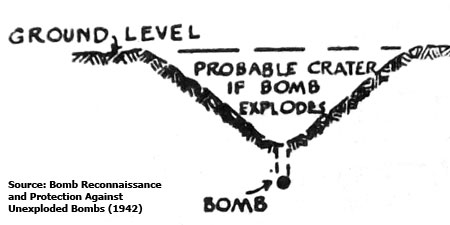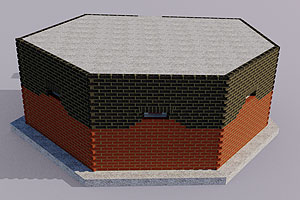Bomb craters (1)
Posted: 13 June 2012 23:42
Over the past few years I've been looking into bomb craters - literally! A combination of documentary and landscape evidence has revealed some amazing stories.
This is the first in a series of posts looking at a feature that survives in the landscape more than you might think.
Firstly, a teaser for you - which is the odd one out in the following list and why?
1. A Bofors anti-aircraft gun position
2. A Home Guard Auxiliary Unit observation post
3. The impact site of a V1 flying bomb
The answer will be revealed in the final part of this series!
Before we start looking at some craters, we need to get some background information:

Crater shapes and types
Let's first get an idea of the mechanics behind bomb crater creation.
In a nutshell - bomb hits ground - possibly leaves some impression of impact or detonation, or both.
The diagram at right shows a basic crater shape, and this is the type that we'll be looking at in detail.
The diagram below, however, shows the variety of craters that were encountered during the war. The illustrations date to 1940 and were reproduced and expanded in various manuals as the war progressed.
These craters and the notes I've summarised are from September 1940 and were based on data collected from two bombed aerodromes.

Crater size and depth
As you can imagine, craters may vary in all sorts of ways; Bomb Reconnaissance and Protection Against Unexploded Bombs (1942) gives us the following information:
The depth to which bombs penetrate depends on:
1. The height from which dropped (up to about 15,000 ft, after which there is no added penetration.)
2. To some extent, the weight of the bomb. (Heavier bombs go deeper.)
3. What the bomb hits before reaching the ground.
4. The nature of the ground surface (concrete etc., or soft ground).
5. The nature of the soil.
An issue for us here is that we have all this wonderful data about the sorts of craters and camouflets that were potentially hazardous, harbouring unexploded ordnance or a nasty pit full of carbon monoxide. But what we really need, however, is data about the harmless sort of crater - one in which the bomb is known to have exploded on or near the surface as shown in the top diagram or in Figure 5 above.
The problem is that these were of practically no concern to Bomb Disposal teams once they had been reconnoitered and declared safe, so the Manual of Bomb Disposal doesn't include the sort of dimensions to help us identify bomb craters 70 years on.
However, we do have some very useful data in reports and surveys conducted by the Home Office's Research and Experiments Department to assess the effectiveness of German bombs and measures to defend against them.
| Bomb Weight | Crater Diameter | Crater Depth |
|---|---|---|
| 50 KG | 8-12 ft (2.4 - 3.6m) | 2-5 ft (0.6 - 1.5m) |
| 100 KG | 20-30 ft (6-9.1m) | 7-10 ft (2.1-3m) |
| 250 KG | 24-36 ft (7.3-11m) | 10-12 ft (3-3.7m) |
| 500 KG | 30-40 ft (9.1-12.2m) | 10-16ft (3-4.9m) |
A report from September 1940 includes the table of data at right as a means of identifying the weight of bombs by the craters they formed.
We can put this data to the test using the following extract from a War Diary of October 1940: "A Heinkel III dropped one bomb in a field near Pevensey Castle. Made 20ft. diameter crater which rapidly filled with water. Nearest bomb dropped as yet to Pevensey Castle."
Using our crater size data, we can speculate that the weapon in question was a 100kg bomb, although Objects Dropped from the Air (and the other aforementioned manuals) don't list a German 100kg bomb. It does, however, describe an Italian bomb of dimensions similar to those given in the 1940 report, while the German 110 kg oil bomb is too large. From the key manuals and reports of incidents in Sussex, it seems that the main German bombs were the 50, 250 and 500 Kg, with the occasional mention of the larger (1,000+ Kg) range.
What we have here is a potential problem; was the Pevensey Castle crater of 20 feet actually measured or a just a rough estimate? If the latter, then the crater might have been 24+ feet and therefore possibly the work of a 250kg bomb. A 2008 visit to the map reference given in the diary uncovered no remaining evidence of the crater.
Another incident described by a different unit in August 1940: "2 bombs dropped by enemy aircraft...Craters 40' wide and 10' deep. No casualties." These dimensions fit the data for 500 kg bombs.
We shall see some more accurate data in due course; I'll finish this episode here, fully aware that I've not yet shown you any evidence of an existing bomb crater.
Oh, go on then:

We'll take a look at this one and its sibling in part 2!
- Pete

Email:
Blog Latest

Bishopstone reveals its pillbox secrets
18 October 2021

Pillbox or Observation Post?
10 June 2020

Uncovering the hidden secrets of a pillbox
8 June 2019

Review of 2018
31 December 2018

Wartime Christmas in East Sussex (2)
24 December 2018
Jargon-buster
War diary
A record of events kept by all units from the point of mobilisation. A diary's contents vary enormously from unit to unit; some give detailed entries by the hour on a daily basis while others merely summarise events on a weekly/monthly basis.
This site is copyright © Peter Hibbs 2006 - 2024. All rights reserved.
Hibbs, Peter Bomb craters (1) (2024) Available at: http://pillbox.org.uk/blog/216701/ Accessed: 27 July 2024
The information on this website is intended solely to describe the ongoing research activity of The Defence of East Sussex Project; it is not comprehensive or properly presented. It is therefore NOT suitable as a basis for producing derivative works or surveys!